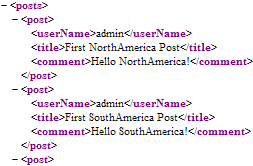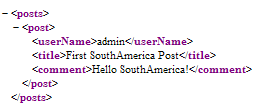Direct Action
We have been dealing with component actions up to now.
Component actions are stateful and are tied closely with page cycles.
No state is encoded in the URL.
However, there are times where you need direct access
to application functionality based on the URL
(special application landing pages, web API's, etc).
The AribaWeb direct actions are created for these purposes.
They are essentially servlet request handlers with access to the AW environment.
We'll build on our GuestBook application as follows:
- Allow XML export to the list of posts
- Add export link
- Enhance the export API to return one post with a parameter
In this guide, you will learn the following:
A pre-requisite to this guide is Cycles And Scopes,
Direct Action Class
Creating a custom direct action class ais like creating a custom session class.
We start by creating the DirectAction class
in the app package by subclassing AWDirectAction:
package app;
import ariba.ui.aribaweb.core.AWDirectAction;
public class DirectAction extends AWDirectAction
{
}
The app.DirectAction class is automatically used if presented.
Direct Action Method
Next we add a direct action method with "Action" as the suffix:
import ariba.ui.aribaweb.core.AWResponseGenerating;
import ariba.ui.aribaweb.core.AWResponse;
...
public AWResponseGenerating postsAction () {
AWResponse response = application().createResponse(request());
response.appendContent("Hello World!");
return response;
}
Hitting the following URL and see the message appear:
http://localhost:8150/GuestBook/Main/ad/posts

You can tell it is a direct action by the "ad" path.
A component action will have the "aw" path instead.
The action will be exposed in the URL without the "Action" suffix.
So how do we programmatically construct this URL?
Direct Action URL
We can use API's in AWDirectActionUrl to construct direct action URL's.
Let's add a native hyperlink to the direct action.
In DirectAction.java, add this string constant:
public static final String PostsAction = "posts";
Next, add this link to Main.awl:
<h1>Past Comments</h1>
<a class="flR" href ="$exportURL">Export XML</a>
Then, define exportURL in Main.java like this:
import ariba.ui.aribaweb.core.AWDirectActionUrl;
...
public String exportURL () {
AWDirectActionUrl url =
AWDirectActionUrl.checkoutFullUrl(requestContext());
url.setDirectActionName(DirectAction.PostsAction);
return url.finishUrl();
}

Click on the link and see that we got the same URL.
The URL scheme is actually this:
http://<host>/<servletName>/<appName>/ad/<actionName>/<className>
If className is not specified, then it is either DirectAction or AWDirectAction.
If actionName is not specified, then it is defaultAction.
When we hit the application's front door,
we are in fact calling the defaultAction in AWDirectAction.
You can override this method to control the front page display.
Response Generation
We can use the power of AribaWeb components to generate more than just UI pages.
It can used to genearate emails, csv, XML, JSON, etc.
Let's replace our simple message with some real content in XML format.
First, create PostContent.awl with this:
<?xml version="1.0" encoding="UTF-8"?>
<posts>
<a:For list="$posts" item="$currPost">
<post>
<userName>$currPost.userName</userName>
<title>$currPost.title</title>
<comment>$currPost.comment</comment>
</post>
</a:For>
</posts>
Next, create the corresponding PostContent.java with this:
package app;
import ariba.ui.aribaweb.core.AWComponent;
import java.util.List;
public class PostContent extends AWComponent
{
private List _posts;
public Post _currPost;
public boolean shouldCachePage () {
return false;
}
protected boolean shouldValidateSession () {
return false;
}
public void setPosts (List posts) {
_posts = posts;
}
public List posts () {
return _posts;
}
}
We need to override shouldCachePage and shouldValidSession to
flag that we are doing content generation instead of creating a stateful page.
We need to specify the response content type as text/xml,
so let's add this in DirectAction.java:
import ariba.ui.aribaweb.util.AWContentType;
...
AWResponse response = application().createResponse(request());
response.setContentType(AWContentType.TextXml);
Next, we create the page and initialize it with the list of posts:
import java.util.List;
...
List posts = Post.Posts;
PostContent postContent =
(PostContent)pageWithName(PostContent.class.getName());
postContent.setPosts(posts);
Then, we call generateResponse to generate the actual content:
postContent.generateResponse(response, requestContext());
return response;
Let's also check that the request method is a "GET":
...
AWRequest request = request();
...
if ("GET".equals(request.method())) {
...
}
return response;

Hit the url in the browser, and it should format the
XML nicely since we provided the right content type.
You see how we get headers from an instance of AWRequest,
and set header and content to an instance of AWResponse as you would expect.
The request object has other information we can use.
Let's enhance our direct action by return
a specific post given the index in the query string...
Request Parameters
We get request parameters from the request with requestValueForKey like this:
import ariba.util.core.ListUtil;
...
String pi = request.formValueForKey("pi");
List posts = Post.Posts;
if (pi != null) {
int postIndex = Integer.parseInt(pi);
posts = ListUtil.list(Post.Posts.get(postIndex));
}
PostContent postContent =
(PostContent)pageWithName(PostContent.class.getName());
...
We can some exception handling if the request method is not a "GET"
by setting the status header:
import ariba.util.core.HTTP;
...
if ("GET".equals(request.method())) {
...
} else {
response.setStatus(HTTP.CodeNotImplemented);
response.appendContent("<Status>Not Implemented</Status>");
}
Finally, let's hit this url:
http://localhost:8150/GuestBook/Main/ad/posts?pi=1

Keep in mind that direct actions are public by default.
You would want to protect it in some ways when appropiate.
You can restrict by request by checking password in the request.
You can restrict by IP by implementing isValidRemoteHost in AWDirectAction
You can restrict by session by implementing session validation (see AWSessionValidator
and initSessionValidator in the Demo Application class).
Back to Documentation